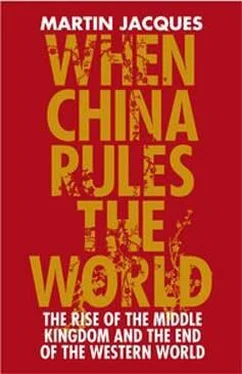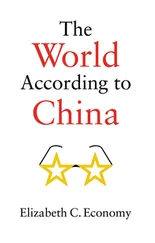We are, thus, confronted with a number of intriguing questions. Will China regain its regional pre-eminence? How long is that likely to take? How might it be achieved? What might that regional pre-eminence look like, what forms will it take, and to what extent might it bear strong echoes of the past?
At the beginning of the 1990s China, with the reform era already a decade old, still existed for the most part in a state of splendid isolation, a condition that it had inherited from the Maoist era. The suppression of the Tiananmen Square demonstration exacerbated this state of affairs, leading to China ’s estrangement by the West and its condemnation by Japan. [865] [865] Though the ASEAN countries importantly did not condemn China, see David Shambaugh, ‘Return to the Middle Kingdom? China and Asia in the Early Twenty-first Century’, in Shambaugh, Power Shift , p. 26.
Throughout the nineties, China steadfastly refused to countenance being a party to any regional multilateral arrangements, [866] [866] It became merely a consultative partner of the ASEAN Regional Forum in 1994.
fearing that it would be obliged to play second-fiddle to Japan, aware that the United States was strongly opposed to regional organizations from which it was likely to be excluded [867] [867] Wang Jisi, ‘ China ’s Changing Role in Asia ’, p. 4, available at www.irchina.org.
and, not least, still imbued with that traditional regional aloofness born of its pervasive sense of superiority. It was only in the early 1990s that China had established diplomatic relations with South Korea, Singapore, Indonesia, Vietnam and Brunei. [868] [868] Yu Bin, ‘ China and Russia: Normalizing Their Strategic Partnership’, in Shambaugh, Power Shift , p. 232. China has also managed to agree all its borders with its East Asian neighbours, the outstanding exception being those with India.
By the end of the decade, however, China had determined on a very different strategy, one that it was to implement with breathtaking speed.
Already, in 1994, it had established the Shanghai Five with Russia, Kazakhstan, Kyrgyzstan and Tajikistan in response to the collapse of the Soviet Union in Central Asia and a desire to engage with Russia and foster co operation on its traditionally troublesome north-western border. It was not until 2001, however, with the formal establishment of the Shanghai Co-operation Organization (SCO), that this was to be translated into something more thorough-going, with a permanent office in Shanghai, the addition of Uzbekistan and the acquisition of new and more extensive functions. [869] [869] Shambaugh, Power Shift , p. 30; John W. Garver, ‘ China ’s Influence in Central and South Asia: Is It Increasing?’, in Shambaugh, Power Shift , p. 211; and Yu Bin, ‘ China and Russia ’, p. 236.
The purpose of the SCO would appear to be threefold: to promote cooperation in Central Asia, to counter Islamic extremism and to resist American influence in the region. Over the subsequent years, India, Iran, Pakistan, Mongolia and Afghanistan have acquired observer status, while representatives are also invited from ASEAN and the CIS (composed of the former Soviet Republics). SCO’s future is difficult to assess but it certainly represents a powerful bloc of Central Asian countries and, significantly, remains outside the aegis of American influence. The heart of China ’s new strategy, though, lay not to its north-west but to its south-east, a region towards which, in comparison, China had for centuries displayed for the most part benign neglect and traditional indifference. It is no exaggeration to suggest that the fulcrum of China ’s strategy in East Asia — certainly as it has evolved over the last decade — came to hinge on a volte-face in its attitude towards ASEAN, the organization of the ten nations of South-East Asia that was formed in 1967. [870] [870] Zhang Yunling, East Asian Regionalism and China (Beijing: World Affairs Press, 2005), pp. 31- 2.
How do we explain China ’s belated embrace of multilateralism? First and foremost, its dramatic economic growth after 1978 generated a growing sense of self-confidence and enabled the country to entertain new and more ambitious perspectives. Second, by the turn of the century China was on the verge of membership of the World Trade Organization, thereby marking its entry into the global international system and signalling its global acceptance of multilateralism. Third, China felt increasingly comfortable about its position in the region and confident that it would not be required to play the role of subordinate to Japan. Finally, as a consequence of the Asian financial crisis in 1997-8, which ravaged the economies of South-East Asia (and South Korea), China found itself thrown into an increasingly close relationship with them. As they struggled to emerge from the effects of the crisis, now rudely aware — after a long period of spectacular economic growth — of their vulnerability to global volatility and bruised by the damaging effects of the US and IMF-imposed solutions to the crisis, the ASEA N countries began to see China in a new light. [871] [871] Ibid., p. 67.
From being a rival to be feared, its motives always the subject of suspicion, China increasingly came to be seen as a friend and partner, primarily because it refrained from devaluing the renminbi, a move which would have inflicted even further pain on their economies, together with its willingness to extend aid and interest-free loans during the crisis. [872] [872] Shambaugh, ‘Return to the Middle Kingdom? China and Asia in the Early Twenty-first Century’, in Shambaugh, Power Shift , pp. 26- 7.
The Malaysian prime minister Mahathir Mohamad remarked in 1999: ‘Chi na’s performance in the Asian financial crisis has been laudable, and the countries in this region… greatly appreciated China ’s decision not to devalue the yuan [renminbi]. China ’s cooperation and high sense of responsibility has spared the region a much worse consequence.’ [873] [873] Quoted in David C. Kang, China Rising: Peace, Power, and Order in East Asia (New York: Columbia University Press, 2007), p. 131.
A decade earlier a rapprochement between ASEAN and China would have been inconceivable; now it had a certain air of inevitability. But it required, on the part of the Chinese, a leap of imagination, a new kind of mindset, a willingness to abandon old ways of thinking, and a boldness that had previously characterized their economic reform programme, though not their conduct of regional relations.
What was surprising was not simply that China was suddenly prepared to embrace multilateralism in the region but also the manner in which it did so. This, after all, was the country that down the ages, from Tang to Mao, had regarded its neighbours with a sense of superiority and indifference: China did not need its neighbours, but they needed it. Yet China was prepared to engage with ASEAN, an organization composed — broadly speaking — of the weakest nations in East Asia, and to do so on its terms rather than China ’s. China ’s approach, in other words, was informed by a new and unfamiliar humility. Historically, North-East Asia, home to old and powerful civilizations like Japan and Korea as well as China, has been overwhelmingly predominant over the much less developed South-East Asia, where a lower level of economic development, ethnic diversity and a weak sense of nationhood have long been manifest. [874] [874] Anthony Reid, ‘Nationalisms in South East Asia ’, Asia Research Institute, National University of Singapore seminar paper, 24 January 2006.
There was now a remarkable inversion, at least in terms of diplomacy, of this traditional state of affairs.
Читать дальше












